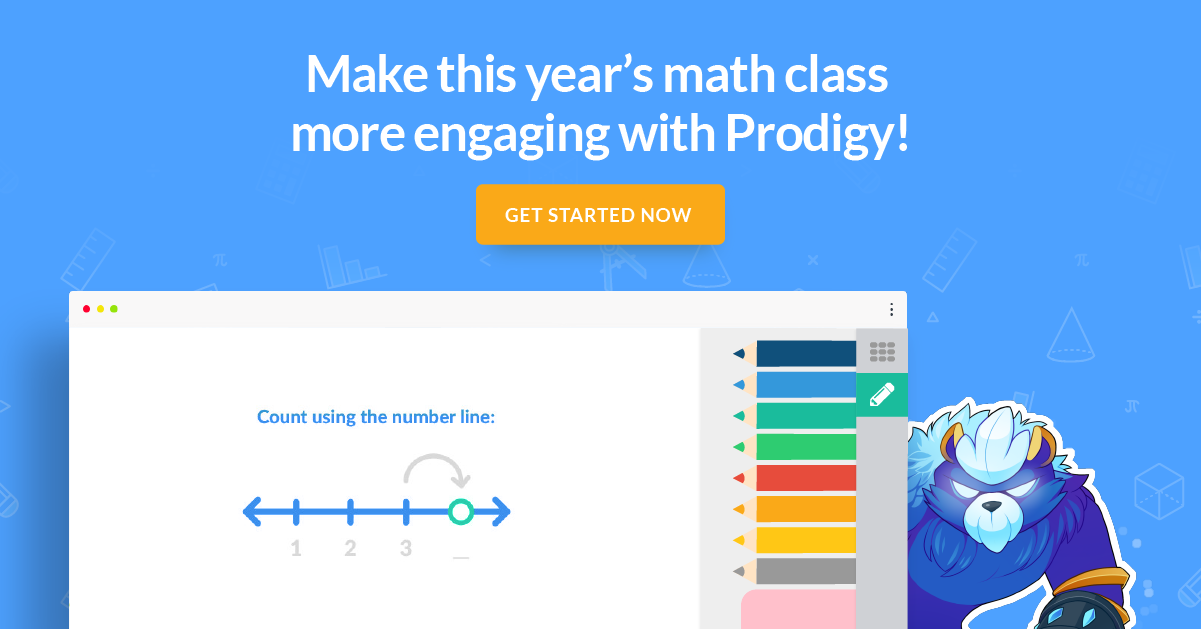20 Exciting Math Games for Kids to Skyrocket New Math Skills On-The-Go
Playing math games has emerged as a way to make class engaging, but you must ensure these activities build skills and reinforce lesson content.
Just like there are many helpful math websites, there are online and offline games suited for this job. They can act as customizable entry and exit tickets, as well as mid-class activities.
For 1st to 8th-grade teachers, here are 20 math games for kids you can play with and without computers:
1. Prodigy
 Students playing Prodigy on their tablets[/caption]Sign up for Prodigy -- a free, curriculum-aligned math video game -- to engage your class as you reinforce lesson content and essential skills.It borrows elements from role-playing games (RPGs) such as Pokemon, as players compete in math duels against in-game characters. To win, they must answer sets of questions.As a teacher, you can customize these questions to supplement class material. The game also uses adaptive learning and differentiated instruction principles to adjust content, addressing each student’s trouble spots.Create or sign into your free teacher account here:Age Range:1st - 8th GradesMathematics Games Online2. Around the BlockPlay Around the Block as a minds-on activity, using only a ball to practice almost any math skill.First, put together a list of questions related to a skill. Second, have students stand in a circle. Finally, give one student the ball and read aloud a question from your list. Students must pass the ball clockwise around the circle, and the one who started with it must answer the question before receiving it again. If the student incorrectly answers, you can pass the ball to a classmate for the next question. If the student correctly answers, he or she chooses the next contestant.Age Range:3rd - 8th Grades
Students playing Prodigy on their tablets[/caption]Sign up for Prodigy -- a free, curriculum-aligned math video game -- to engage your class as you reinforce lesson content and essential skills.It borrows elements from role-playing games (RPGs) such as Pokemon, as players compete in math duels against in-game characters. To win, they must answer sets of questions.As a teacher, you can customize these questions to supplement class material. The game also uses adaptive learning and differentiated instruction principles to adjust content, addressing each student’s trouble spots.Create or sign into your free teacher account here:Age Range:1st - 8th GradesMathematics Games Online2. Around the BlockPlay Around the Block as a minds-on activity, using only a ball to practice almost any math skill.First, put together a list of questions related to a skill. Second, have students stand in a circle. Finally, give one student the ball and read aloud a question from your list. Students must pass the ball clockwise around the circle, and the one who started with it must answer the question before receiving it again. If the student incorrectly answers, you can pass the ball to a classmate for the next question. If the student correctly answers, he or she chooses the next contestant.Age Range:3rd - 8th Grades3. Math Baseball

4. Bouncing Sums
Give students a chance to move around class by playing Bouncing Sums, building mental math muscles. To prepare, use labels and a marker to put integers, decimals, or fractions on a beach ball. Hand the ball to one student, who will read aloud the label by touching one of his or her thumbs. That student tosses the ball to a classmate, and so on. Each student must read the number on his or her label, adding it to -- or multiplying it with -- the sum or product that the previous student stated. The challenge? Reach the highest number possible within a time limit. Age Range:3rd - 8th Grades
To prepare, use labels and a marker to put integers, decimals, or fractions on a beach ball. Hand the ball to one student, who will read aloud the label by touching one of his or her thumbs. That student tosses the ball to a classmate, and so on. Each student must read the number on his or her label, adding it to -- or multiplying it with -- the sum or product that the previous student stated. The challenge? Reach the highest number possible within a time limit. Age Range:3rd - 8th Grades5. Math Facts Race
Keep combining math with physical activity in this fast-paced fact fluency drill. Divide students into teams at the back of the class, posting a grid sheet at the front for each group. One student from each team will run to the sheet, writing an answer in the appropriate grid. To practice multiplication, for example, a student would have to write 12 in the grid where the third row and fourth column meet. The student returns to his or her team after answering, allowing a group member to run to the sheet. The group member can fill another grid or, if needed, correct a previous answer. This process repeats itself until a team wins by correctly filling its sheet.Age Range:2nd - 5th Grades6. Math Facts Bingo
 Make fact fluency drills engaging by playing this version of bingo.First, create bingo cards that contain answers to different multiplication tables. Second, hand them out to students and make sure they have a separate sheet for calculations. Finally, instead of calling numbers, state equations such as 8 × 7. After determining the product is 56, they can check off the number if it’s on their cards.Age Range:3rd - 6th Grades
Make fact fluency drills engaging by playing this version of bingo.First, create bingo cards that contain answers to different multiplication tables. Second, hand them out to students and make sure they have a separate sheet for calculations. Finally, instead of calling numbers, state equations such as 8 × 7. After determining the product is 56, they can check off the number if it’s on their cards.Age Range:3rd - 6th Grades7. Math Is Fun
Engage elementary school students by pointing them towards games and puzzles on the Math Is Fun website.Ideal as a learning station or for classes with one-to-one device use, the games range from challenging math classics -- such as Sudoku -- to counting exercises for younger students. The latter category uses concise sentences and cartoon characters, making content easier for these students to process.Age Range:1st - 5th Grades8. 101 and Out

9. One-Meter Dash
Run this quick game to improve perception and understanding of measurement. Grouping students in small teams, give them meter sticks. They then look around the room for two to four items they think add up to one meter long. In a few minutes, the groups measure the items and record how close their estimations were. Want more of a challenge? Give them a centimeter-mark instead of a meter, asking them to convert results to micrometers, millimetres, and more. Age Range:3rd - 5th Grades10. Back-to-Back

11. Math Tic-Tac-Toe
Pair students to compete against one another while practicing different math skills in this take on tic-tac-toe.Prepare by dividing a sheet into squares — three vertical by three horizontal. Don’t leave them blank. Instead, fill the boxes with questions that test different abilities.The first one to link three Xs or Os -- by correctly answering questions -- wins.You can use this game as a learning station, refreshing prerequisite skills in preparation for new content.Age Range:1st - 8th Grades12. Get the Math
Visit Get the Math with your students to solve engaging challenges, each related to using math in different careers and real-world situations.The website contains videos with young professionals who explain how they use math in their fields, such as fashion design and video game development. You can assign challenges to your class after watching, which involve playing games. For example, one is based on using materials with different price-points and measurements to design a shirt for less than $35.Age Range:6th Grade and Up13. Simon Says: Geometry
Appeal to kinesthetic learners by playing this version of Simon Says and, in the process, improve their understanding of basic geometry.As Simon, all your commands should require students to illustrate angles and shapes by moving their arms. For example, ask them to make angles of varying degrees as well as parallel and perpendicular lines. Continuously speed up your commands -- and change if they come from Simon or not -- until only one student remains and is the winner.Age Range:2nd - 3rd Grades14. Math Goodies

15. Initials
Add a game-like spin to content reviews by playing Initials.Hand out a unique sheet to each student with problems aligned to a common skill or topic. Instead of focusing on their own sheets, students walk around the room to solve questions on their classmates’. But there’s catch. A student can only complete one question per sheet, signing his or her initials beside the answer. Working together to reach an individual yet joint goal, students should build trust and teamwork.Age Range:3rd - 8th Grades16. Stand Up, Sit DownPlay Stand Up, Sit Down as a minds-on activity, adjusting the difficulty according to student age and skill level. The principle of the game is straightforward: You pick a number, and students must stand if the answer to an equation you read aloud matches that number. If it isn’t, they remain seated in a circle. You can modify requirements for standing as needed. For example, you can tell students to stand if the answer is:- Greater than 10
- An even number
- A multiple of three
17. 100s
Gather your class in a circle to play 100s as a quick warm-up before your lesson. You’ll give students a set of numbers to choose from -- such as multiples of five to a maximum of 20 -- as they take turns adding out loud in a clockwise direction. The student who says or passes 100 is out. You’ll start again until only one participant is left.Although the game is simple, you can change how it’s played to suit the skills of your students. For example, they may have to multiply by fours instead of adding by files.Age Range:2nd - 8th Grades18. War

- Ace -- 1
- Two to 10 -- Face value
- Jack -- 11
- Queen -- 12
- King -- 13
19. National Library of Virtual Manipulatives

20. Jeopardy
Transform this famous game show to focus on your latest skill or unit, preparing students for a quiz or test.Setup involves attaching pockets to a bristol board, dividing them into columns and rows. Each column should focus on a specific topic, whereas each row should have a point value -- 200, 400, 600, 800 and 1,000. A team can ask for a question from any pocket, but other teams can answer first by solving the problem and raising their hands. Once the class answers all questions, the team with highest point total claims the prize you provide.But each student wins in terms of engagement and practicing peer support.Age Range:3rd to 8th GradesInfographic
Here's an infographic with 10 ideas from this article, provided by Educational Technology and Mobile Learning -- an online resource for teaching tools and ideas: [caption id="attachment_766" align="aligncenter" width="217"] Click to expand.[/caption]
Click to expand.[/caption]Final Thoughts About these 20 Classroom Math Games for Kids
These math games for kids will not only engage students but help you develop their skills and fact fluency while supplementing lessons. Although the recommended age ranges fall between grades 1 and 8, you can certainly modify the content for different skill levels and use them for struggling students in higher grades. And, if you’re unsure about the benefits, try a few games to see the results yourself.>>Create or log into your teacher account on Prodigy-- a free, adaptive math game that adjusts content to accommodate player trouble spots and learning speeds. Aligned to US and Canadian curricula, it’s loved by more than a million teachers and 50 million students.




Comments
Post a Comment